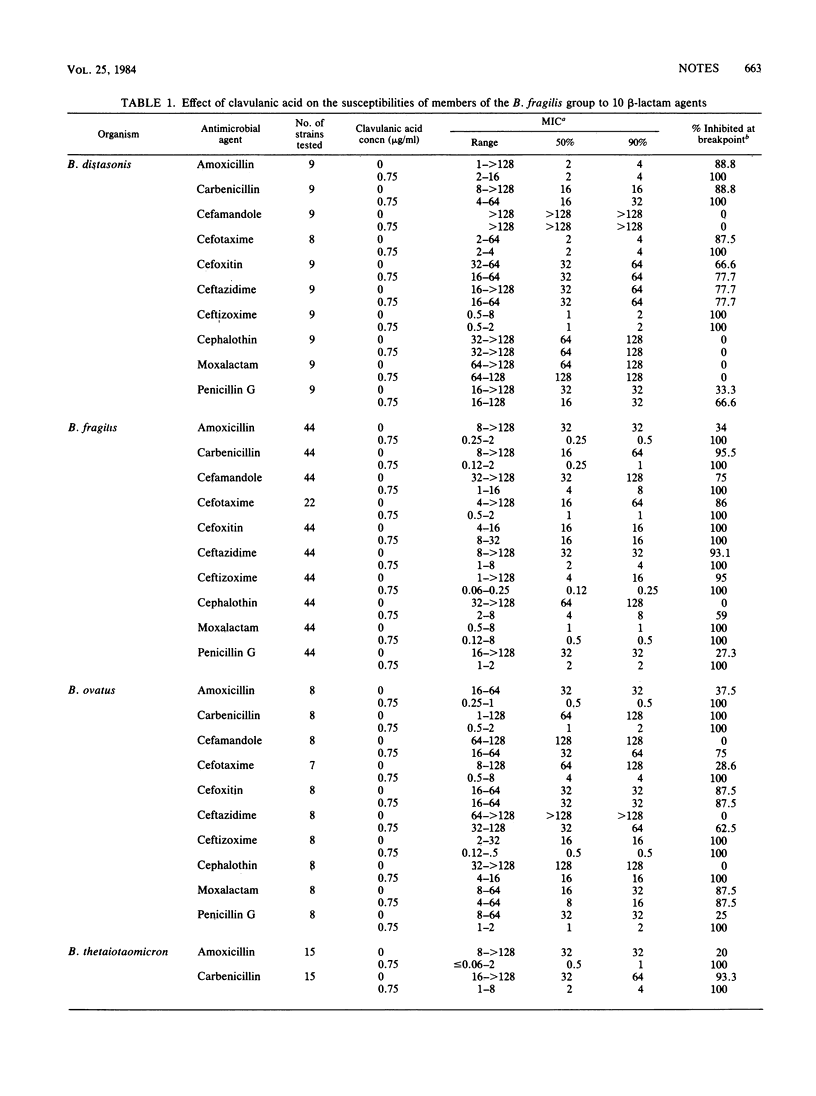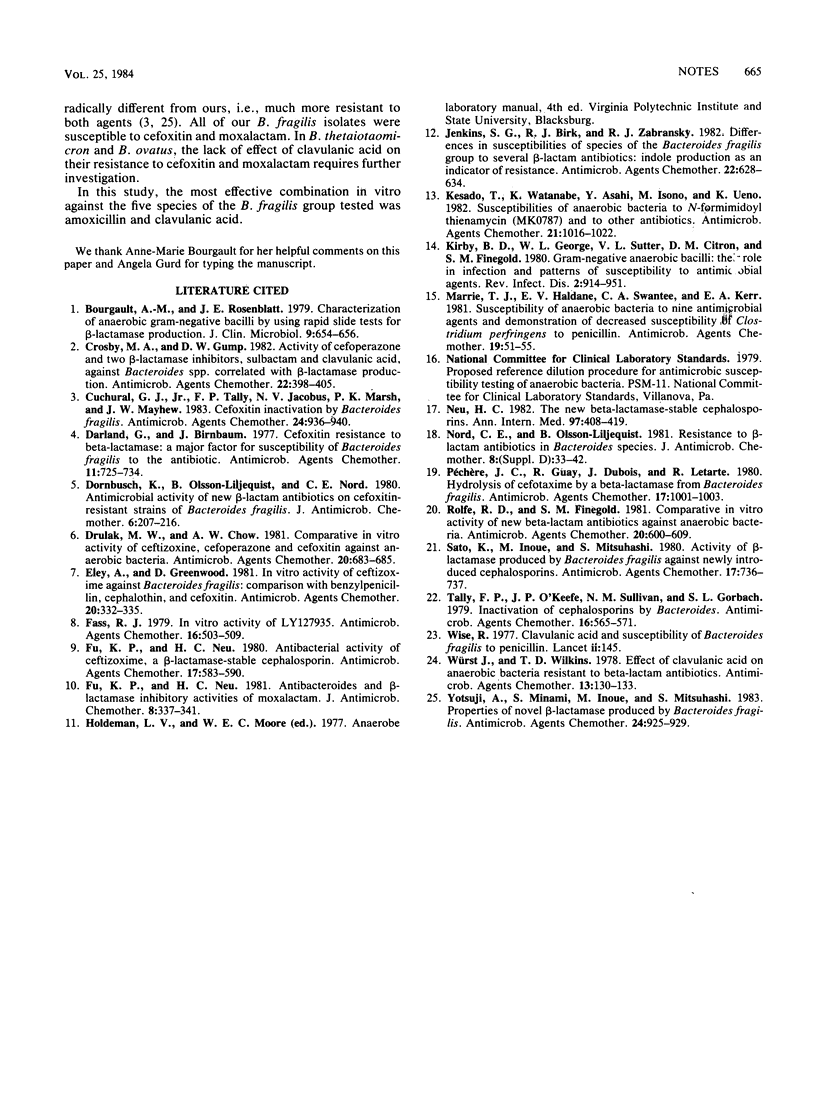Abstract
Clavulanic acid reduced the MICs of amoxicillin, carbencillin , cefamandole, cefotaxime, ceftazidime, ceftizoxime, cephalothin, and penicillin G, but not of cefoxitin or moxalactam, against 77 isolates of the Bacteroides fragilis group, all rapidly beta-lactamase positive by the nitrocefin slide test. It had no effect on the susceptibilities of eight Bacteroides distasonis strains that were slowly beta-lactamase positive (18 h of incubation).
Full text
PDF



Selected References
These references are in PubMed. This may not be the complete list of references from this article.
- Bourgault A. M., Rosenblatt J. E. Characterization of anaerobic gram-negative bacilli by using rapid slide tests for beta-lactamase production. J Clin Microbiol. 1979 Jun;9(6):654–656. doi: 10.1128/jcm.9.6.654-656.1979. [DOI] [PMC free article] [PubMed] [Google Scholar]
- Crosby M. A., Gump D. W. Activity of cefoperazone and two beta-lactamase inhibitors, sulbactam and clavulanic acid, against Bacteroides spp. correlated with beta-lactamase production. Antimicrob Agents Chemother. 1982 Sep;22(3):398–405. doi: 10.1128/aac.22.3.398. [DOI] [PMC free article] [PubMed] [Google Scholar]
- Cuchural G. J., Jr, Tally F. P., Jacobus N. V., Marsh P. K., Mayhew J. W. Cefoxitin inactivation by Bacteroides fragilis. Antimicrob Agents Chemother. 1983 Dec;24(6):936–940. doi: 10.1128/aac.24.6.936. [DOI] [PMC free article] [PubMed] [Google Scholar]
- Darland G., Birnbaum J. Cefoxitin resistance to beta-lactamase: a major factor for susceptibility of bacteroides fragilis to the antibiotic. Antimicrob Agents Chemother. 1977 Apr;11(4):725–734. doi: 10.1128/aac.11.4.725. [DOI] [PMC free article] [PubMed] [Google Scholar]
- Dornbusch K., Olsson-Lijequist B., Nord C. E. Antibacterial activity of new beta-lactam antibiotics on cefoxitin-resistant strains of Bacteroides fragilis. J Antimicrob Chemother. 1980 Mar;6(2):207–216. doi: 10.1093/jac/6.2.207. [DOI] [PubMed] [Google Scholar]
- Drulak M. W., Chow A. W. Comparative in vitro activity of ceftizoxime, cefoperazone, and cefoxitin against anaerobic bacteria. Antimicrob Agents Chemother. 1981 Nov;20(5):683–685. doi: 10.1128/aac.20.5.683. [DOI] [PMC free article] [PubMed] [Google Scholar]
- Eley A., Greenwood D. In vitro activity of ceftizoxime against Bacteroides fragilis: comparison with benzylpenicillin, cephalothin, and cefoxitin. Antimicrob Agents Chemother. 1981 Sep;20(3):332–335. doi: 10.1128/aac.20.3.332. [DOI] [PMC free article] [PubMed] [Google Scholar]
- Fass R. J. In vitro activity of LY127935. Antimicrob Agents Chemother. 1979 Oct;16(4):503–509. doi: 10.1128/aac.16.4.503. [DOI] [PMC free article] [PubMed] [Google Scholar]
- Fu K. P., Neu H. C. Antibacterial activity of ceftizoxime, a beta-lactamase-stable cephalosporin. Antimicrob Agents Chemother. 1980 Apr;17(4):583–590. doi: 10.1128/aac.17.4.583. [DOI] [PMC free article] [PubMed] [Google Scholar]
- Fu K. P., Neu H. C. Antibacteroides and beta-lactamase inhibitory activities of moxalactam. J Antimicrob Chemother. 1981 Oct;8(4):337–341. doi: 10.1093/jac/8.4.337. [DOI] [PubMed] [Google Scholar]
- Jenkins S. G., Birk R. J., Zabransky R. J. Differences in susceptibilities of species of the Bacteroides fragilis group to several beta-lactam antibiotics: indole production as an indicator of resistance. Antimicrob Agents Chemother. 1982 Oct;22(4):628–634. doi: 10.1128/aac.22.4.628. [DOI] [PMC free article] [PubMed] [Google Scholar]
- Kesado T., Watanabe K., Asahi Y., Isono M., Ueno K. Susceptibilities of anaerobic bacteria to N-formimidoyl thienamycin (MK0787) and to other antibiotics. Antimicrob Agents Chemother. 1982 Jun;21(6):1016–1022. doi: 10.1128/aac.21.6.1016. [DOI] [PMC free article] [PubMed] [Google Scholar]
- Kirby B. D., George W. L., Sutter V. L., Citron D. M., Finegold S. M. Gram-negative anaerobic bacilli: their role in infection and patterns of susceptibility to antimicrobial agents. I. Little-known Bacteroides species. Rev Infect Dis. 1980 Nov-Dec;2(6):914–951. doi: 10.1093/clinids/2.6.914. [DOI] [PubMed] [Google Scholar]
- Marrie T. J., Haldane E. V., Swantee C. A., Kerr E. A. Susceptibility of anaerobic bacteria to nine antimicrobial agents and demonstration of decreased susceptibility of Clostridium perfringens to penicillin. Antimicrob Agents Chemother. 1981 Jan;19(1):51–55. doi: 10.1128/aac.19.1.51. [DOI] [PMC free article] [PubMed] [Google Scholar]
- Neu H. C. The new beta-lactamase-stable cephalosporins. Ann Intern Med. 1982 Sep;97(3):408–419. doi: 10.7326/0003-4819-97-3-408. [DOI] [PubMed] [Google Scholar]
- Nord C. E., Olsson-Liljequist B. Resistance to beta-lactam antibiotics in Bacteroides species. J Antimicrob Chemother. 1981 Dec;8 (Suppl 500):33–42. doi: 10.1093/jac/8.suppl_d.33. [DOI] [PubMed] [Google Scholar]
- Pechère J. C., Guay R., Dubois J., Letarte R. Hydrolysis of Cefotaxime by a beta-lactamase from Bacteroides fragilis. Antimicrob Agents Chemother. 1980 Jun;17(6):1001–1003. doi: 10.1128/aac.17.6.1001. [DOI] [PMC free article] [PubMed] [Google Scholar]
- Rolfe R. D., Finegold S. M. Comparative in vitro activity of new beta-lactam antibiotics against anaerobic bacteria. Antimicrob Agents Chemother. 1981 Nov;20(5):600–609. doi: 10.1128/aac.20.5.600. [DOI] [PMC free article] [PubMed] [Google Scholar]
- Sato K., Inoue M., Mitsuhashi S. Activity of beta-lactamase produced by Bacteroides fragilis against newly introduced cephalosporins. Antimicrob Agents Chemother. 1980 Apr;17(4):736–737. doi: 10.1128/aac.17.4.736. [DOI] [PMC free article] [PubMed] [Google Scholar]
- Tally F. P., O'Keefe J. P., Sullivan N. M., Gorbach S. L. Inactivation of cephalosporins by Bacteroides. Antimicrob Agents Chemother. 1979 Nov;16(5):565–571. doi: 10.1128/aac.16.5.565. [DOI] [PMC free article] [PubMed] [Google Scholar]
- Wise R. Clavulanic acid and susceptibility of Bacteroides fragilis to penicillin. Lancet. 1977 Jul 16;2(8029):145–145. doi: 10.1016/s0140-6736(77)90161-1. [DOI] [PubMed] [Google Scholar]
- Wüst J., Wilkins T. D. Effect of clavulanic Acid on anaerobic bacteria resistant to Beta-lactam antibiotics. Antimicrob Agents Chemother. 1978 Jan;13(1):130–133. doi: 10.1128/aac.13.1.130. [DOI] [PMC free article] [PubMed] [Google Scholar]
- Yotsuji A., Minami S., Inoue M., Mitsuhashi S. Properties of novel beta-lactamase produced by Bacteroides fragilis. Antimicrob Agents Chemother. 1983 Dec;24(6):925–929. doi: 10.1128/aac.24.6.925. [DOI] [PMC free article] [PubMed] [Google Scholar]


